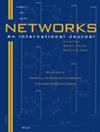Exact solution approaches for the discrete α‐neighbor p‐center problem
IF 1.3
4区 计算机科学
Q4 COMPUTER SCIENCE, HARDWARE & ARCHITECTURE
引用次数: 0
Abstract
The discrete ‐neighbor ‐center problem (d‐‐CP) is an emerging variant of the classical ‐center problem which recently got attention in literature. In this problem, we are given a discrete set of points and we need to locate facilities on these points in such a way that the maximum distance between each point where no facility is located and its ‐closest facility is minimized. The only existing algorithms in literature for solving the d‐‐CP are approximation algorithms and two recently proposed heuristics. In this work, we present two integer programming formulations for the d‐‐CP, together with lifting of inequalities, valid inequalities, inequalities that do not change the optimal objective function value and variable fixing procedures. We provide theoretical results on the strength of the formulations and convergence results for the lower bounds obtained after applying the lifting procedures or the variable fixing procedures in an iterative fashion. Based on our formulations and theoretical results, we develop branch‐and‐cut (B&C ) algorithms, which are further enhanced with a starting heuristic and a primal heuristic. We evaluate the effectiveness of our B&C algorithms using instances from literature. Our algorithms are able to solve 116 out of 194 instances from literature to proven optimality, with a runtime of under a minute for most of them. By doing so, we also provide improved solution values for 116 instances.离散α近邻p中心问题的精确解方法
离散邻近中心问题(d - CP)是近年来在文献中引起关注的经典中心问题的一个新变体。在这个问题中,我们有一个离散的点集,我们需要在这些点上定位设施,使每个没有设施的点与其最近的设施之间的最大距离最小。文献中仅有的求解d‐‐CP的算法是近似算法和最近提出的两种启发式算法。在这项工作中,我们提出了d‐‐CP的两个整数规划公式,以及不等式的解除,有效不等式,不改变最优目标函数值的不等式和变量的固定过程。我们提供了关于公式强度的理论结果和在迭代方式下应用提升程序或变量固定程序后得到的下界的收敛结果。基于我们的公式和理论结果,我们开发了分支和切断(B&C)算法,该算法通过起始启发式和原始启发式进一步增强。我们使用文献中的实例来评估我们的B&C算法的有效性。我们的算法能够解决194个实例中的116个,从文献到已证明的最优性,其中大多数的运行时间不到一分钟。通过这样做,我们还为116个实例提供了改进的解决方案值。
本文章由计算机程序翻译,如有差异,请以英文原文为准。
求助全文
约1分钟内获得全文
求助全文
来源期刊

Networks
工程技术-计算机:硬件
CiteScore
4.40
自引率
9.50%
发文量
46
审稿时长
12 months
期刊介绍:
Network problems are pervasive in our modern technological society, as witnessed by our reliance on physical networks that provide power, communication, and transportation. As well, a number of processes can be modeled using logical networks, as in the scheduling of interdependent tasks, the dating of archaeological artifacts, or the compilation of subroutines comprising a large computer program. Networks provide a common framework for posing and studying problems that often have wider applicability than their originating context.
The goal of this journal is to provide a central forum for the distribution of timely information about network problems, their design and mathematical analysis, as well as efficient algorithms for carrying out optimization on networks. The nonstandard modeling of diverse processes using networks and network concepts is also of interest. Consequently, the disciplines that are useful in studying networks are varied, including applied mathematics, operations research, computer science, discrete mathematics, and economics.
Networks publishes material on the analytic modeling of problems using networks, the mathematical analysis of network problems, the design of computationally efficient network algorithms, and innovative case studies of successful network applications. We do not typically publish works that fall in the realm of pure graph theory (without significant algorithmic and modeling contributions) or papers that deal with engineering aspects of network design. Since the audience for this journal is then necessarily broad, articles that impact multiple application areas or that creatively use new or existing methodologies are especially appropriate. We seek to publish original, well-written research papers that make a substantive contribution to the knowledge base. In addition, tutorial and survey articles are welcomed. All manuscripts are carefully refereed.
 求助内容:
求助内容: 应助结果提醒方式:
应助结果提醒方式:


